20 Easy Ideas For Setting Up A Nursery In Your Small Space

Your new little one will take up a lot of room in your heart, but they don’t necessarily have to take up a lot of room in your home!
Having a small living space doesn’t mean you can’t have an adorable nursery. What it does mean is that you need plenty of small nursery ideas! It’s time to get creative and make the most of every square inch.
At Newton Baby, we get excited about safe, cozy spaces for babies to grow and thrive in. We’ve put together this list of 20 small nursery ideas so you can create the perfect room for your precious baby no matter how much (or little) space you have!
But before we let you in on these ideas, let’s talk about safety. Regardless of how big or small your nursery is, safety is one thing that should never be compromised.
Small Nursery Safety
You don’t have to compromise on safety just because you have a tiny space! Here are a few safety tips to keep in mind as you design and decorate your small nursery.
Outfit Your Nursery For Safe Sleep
Your little one will spend lots of time napping and snoozing in their crib. In just a few simple steps, you’ll make their bed a safe place for them to sleep and give yourself peace of mind knowing that they’re protected.
First, set your baby up in their own bed. No matter how tiny your home is, don’t put your infant in bed with you to sleep. If you’re extra tight on space, put them in a bassinet or a mini-crib.
Second, outfit your little one’s crib with a safe, firm mattress that fits properly. A good fit leaves no gaps between the edge of the mattress and the inside of the crib. You should not be able to fit more than two fingers between them.
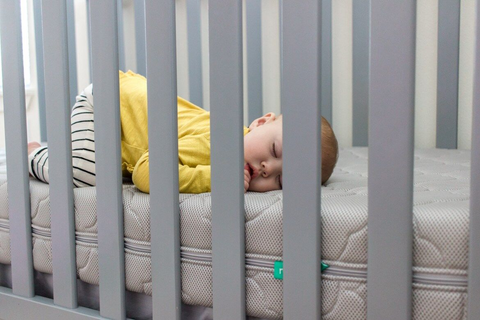
For even more peace of mind, put your baby to sleep on a breathable mattress, like Newton Baby’s Crib Mattress.
Our crib mattresses are firm yet comfortable and 100% breathable. This not only helps to reduce the risk of suffocation but also helps regulate your baby’s body temperature (no more sweaty backs!) and reduce dust mites and allergens.
Lastly, once your little one is in your arms, ask your pediatrician about safe sleep guidelines, like putting your baby to sleep on their back and offering them a pacifier.
Choose Safe Crib Decorations
Even in a small room, it’s tempting to go all out with decorations like cute throw pillows and blankets. But in the name of safe sleep, skip the extra bells and whistles on the crib.
To provide your little one with the safest possible rest, keep all toys, books, pillows, blankets, and crib bumpers out of the crib. You’ll also want to make sure the bedding is not too loose.
If you’d like to simplify your life while continuing to keep your baby safe, choose a Newton Baby Crib Mattress. Our mattress cover is not only breathable but also completely removable and washable, which makes cleanup a breeze for you!
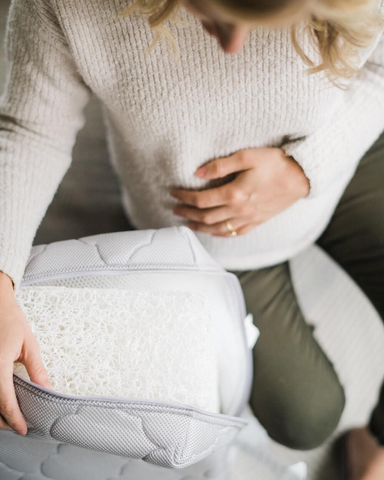
Don’t Leave Your Baby At The Changing Table
With a small nursery, you might toss out the idea of a changing table altogether and look for alternative places to change your baby’s diaper. But if your changing surface is high, remember to never leave your baby alone.
Your little one might learn how to roll over (and off the changing table!) when you least expect it. Keep a hand on your little one at all times, and arrange your nursery so everything you need during a diaper change is within easy reach.
Babyproof The Space
Small nurseries don’t automatically have fewer dangers for your baby. You’ll still need to babyproof the space.
Install outlet covers. Make sure you have a working smoke detector and carbon monoxide detector. And, if you have blinds, secure the cords or swap them out for a cordless variety.
These tasks won’t take long, but they’ll help keep your baby safe while they’re in the nursery.

20 Small Nursery Ideas
With those safety guidelines in mind, let your imagination run wild with ideas for turning your small space into a baby haven!
To get your creative juices flowing, here are Newton Baby’s 20 best small nursery ideas.
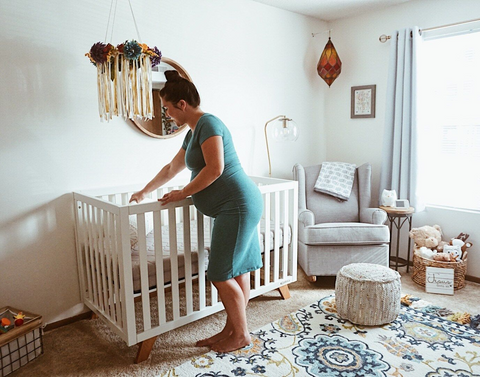
1) Make A Plan
A little bit of time spent planning can save you a lot of time and money down the road. Before you start decorating your baby’s room, read through these small nursery ideas.
Write down the ones that make the most sense for your home and focus on those first. Then, take some time to visualize the finished space and consider these questions:
- What do you want it to look like?
- What colors do you imagine?
- Do you have a nursery theme in mind?
The answers to these questions will help you create the perfect space for your precious baby.
Once you have a rough plan in mind, sketch the room out. That way you can see where everything fits best.
2) Measure The Space
After you’ve made your plan, take some measurements of the room. By doing so, you’ll know exactly how much space you have to work with. Keep these numbers in mind as you go shopping.
And, as you consider each piece of furniture you want to include, check the dimensions carefully. You don’t want to buy anything that won’t fit or will overcrowd the nursery.
3) Prioritize What Goes In The Nursery
Now that you know how much space you have, prioritize what items have to go in the nursery and what can go in another room in the house.
The crib and a few other necessities will need to go in your little one’s room but think outside the box for the rest. Consider putting toys in the living room, for example, or keeping all of your baby’s towels, washcloths, and shampoo in the bathroom.
Think about where you’ll use each item. You want to store your little one’s things in a spot that makes sense. That way, when you’re exhausted and dealing with brain fog, you’ll easily be able to find what you’re looking for.
4) Downsize The Crib
In a tight space, one of the first things to go is the standard-sized crib. Some parents put their newborn to sleep in a bassinet. But within a couple of months, they’ll outgrow a bassinet.
When that happens (or from the very beginning), opt for a mini crib. At 24 inches wide and 38 inches long, the mini crib is smaller than a standard-sized crib and is more space-economical.
Plus, the Newton Baby breathable Crib Mattress is available in both standard and mini sizes, so you don’t have to sacrifice safety!
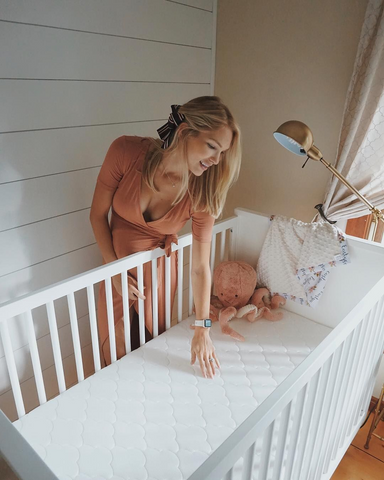
5) Tuck The Crib In A Corner
You might be scratching your head wondering where in the world you’re going to fit a crib.
If you have a closet in your nursery, make a special corner for the crib by removing the closet doors and tucking the crib into the nook you created. Hello, floor space!
No matter where you put the crib, keep safety in mind. Your little baby will soon be a toddler who can pull to stand and climb out of the crib. You don’t want them to be near a window or anything else dangerous when that happens.
6) Add Storage Under The Crib
Underneath your baby’s crib is an underutilized space, but this area can give you more storage for your baby’s clothing and supplies.
Measure how much clearance you have under the bottom of the crib. Then, look for baskets, totes, or boxes that easily slide into this space. They’ll help keep things organized, and containers also make it easier to grab what you need.
After all, when you’re holding a baby, you need your storage areas to be easily accessible.
7) Install Curtains Instead Of Doors
Another way to free up space is to keep your closet as a storage area but do away with the doors. Doors that swing in or out just take up valuable floor space.
To create a little extra space, remove swinging closet doors and install a curtain instead. This is also a great way to add a pop of color or a fun pattern to your nursery decor.
Just make sure you install the curtain rod securely. You don’t want it to fall on your baby when they’re older and tugging on it.
8) Choose Your Colors Carefully
Dark colors absorb light, which can make a small nursery feel even more crowded. To avoid this, stick with lighter colors on the walls and ceiling.
Neutral colors are also a good choice that’ll continue to work as your child grows into toddlerhood and beyond. These colors — such as white, gray, and beige — are growing in popularity, and you’re sure to get tons of compliments when you use them!
9) Add Wall Art
Bold wall art really stands out against neutral walls. You can use framed pictures, abstract art, or painted letters to customize your baby’s nursery.
Whatever you decide to include, look for art that goes with the theme you pick and that makes you smile when you see it.

10) Reimagine The Changing Table
To save space and maximize storage, reimagine your changing area. Sure, it needs to have diapers, wipes, and baby rash cream. But it doesn’t need to take up a lot of space or have a singular purpose.
Instead, turn the bottom of the changing table into storage. Or forego the changing table altogether and turn your baby’s dresser into a changing area (or your dresser if your room is functioning as the nursery!).
You can even purchase a crib-top changing table, which is a little changing area that rests securely on top of the crib. When you’re not using it, store it under the crib or slide it into the closet so it’s not in the way.
11) Use Your Door Space
Use an over-the-door organizer to add storage to your small nursery. These come in many different configurations, so think about what you’d like to store, and find an organizer that meets your needs.
Tip: If you decide on an organizer with pockets, pick a style that you can see through. That way you can easily find what you’re looking for.
12) Make Use Of The Walls
In a small nursery, the walls are your friends!
Mount a stylish rod on the wall to hang clothes, or install a hook to hang a laundry bag or canvas bag full of toys.

A pegboard is another great way to organize all sorts of baby necessities.
You can get little shelves that hang from it, giving you more space for small knick-knacks. And there are even baskets that you can pop into the holes, which work perfectly for baby washcloths, diapers, or other essentials.
You can also use the walls to store all those stuffed animals your little one will inevitably collect. Buy a net (or two!) to hang in the corner to keep your baby’s teddies and dolls cozy, contained, and out of the crib.
13) Light The Room With A Wall Lamp
Instead of adding a floor lamp, stick to the ceiling light and an extra wall lamp.
Having a small wall lamp will allow you to make the room dimmer when you don’t want the overhead light on. And there are lots of wall lamps that are stylish and will fit with just about any decor!
You may also want to consider installing blackout curtains. They won’t take up any extra room and can make a big difference when you’re putting your baby to bed before the sun has gone down!
14) Use Floating Shelves
While we’re on the topic of using wall space, let’s not forget about floating shelves! A few floating shelves will free up floor space and keep things out of a toddler’s curious reach.
You can find floating shelves in a variety of colors and sizes, so it’s easy to choose some that will complement the colors in your nursery.
If you have the space, hang up a couple of shelves instead of just one. That way you have plenty of shelf space for displaying baby books, special toys, and other baby memorabilia.

15) Choose A Small Chair Instead Of A Rocker
A rocker or glider is nice, but if you’re working with a small nursery, it might have to go.
Instead of a big rocker that takes up lots of space, choose a small chair. It might not be as comfortable, but you’ll still have a spot to sit with your little one for bedtime snuggles and stories.
If space is really tight, leave the chair out of the nursery altogether. You can use a comfy chair in the living room for cuddles instead. Your baby won’t remember where you snuggled, they’ll just remember feeling loved.
16) Cut Out Unnecessary Items
When you create a baby registry, you’ll realize that babies require a lot of stuff! But your babe might not need as much as you think.
Think carefully about the baby essentials you need to keep your little one clean, safe, and happy — then don’t be afraid to cut out the unnecessary items so that you can more easily work with small nursery ideas.
For example, a breastfeeding pillow could come in handy, but maybe you can make do with a couple of pillows from your bedroom instead. And while a wipe warmer might sound like a good idea, it isn’t always practical.
For now, stick to the basics. If you decide that you do need something else, you can buy it later on.
17) Keep It Clean

When you keep your baby’s room neat and tidy, it’s much more enjoyable to spend time there. Unfortunately, if you aren’t careful, your small nursery can quickly become packed full of stuff.
To avoid this, take time to declutter this space regularly. Just a few minutes spent putting things back where they belong can make a huge difference.
To make this task simple, keep a basket on the dresser or somewhere nearby. Toss anything that shouldn’t be in the nursery into the basket. Then, when you get a chance, grab the basket and put everything away.
Just remember to put the basket back when you’re done so it’s ready for the next time.
18) Use A Rolling Cart
Though you might not associate a rolling cart with a nursery, it’s a great way to add storage without taking up a lot of floor space. You can organize your baby’s things in each drawer, with one for diapers and wipes, one for clothes, and one for burp cloths.
As a bonus, you can roll the cart around the house. No matter where you are, you have your baby’s essentials on hand!
Tip: If you plan on moving the cart frequently, be sure to invest in a cart with a good set of casters so that it’s more sturdy.
19) Add A Cozy Rug
A cozy rug can transform your small nursery by making the space seem larger.
As a rule of thumb for small spaces, pick a rug with an all-over pattern or a solid color that coordinates with the wall and ceiling.
Keep in mind that you don’t want to pick a rug with too much texture. Thick shag or tufted rugs work better in a larger room.
Also, make sure your rug isn’t going to slip and slide all over the place. If your rug moves, you risk falling when you’re carrying your baby. To stay safe, choose a rug with a non-skid back or put down a rug gripper first.

20) Incorporate Dual-Purpose Furniture
Since you won’t have a lot of space for furniture in your small nursery, each piece needs to be as functional as possible. Look for furniture that can do double duty to maximize the space without cluttering it up.
For example, consider investing in a storage ottoman. An ottoman allows you to put your feet up or have a place to sit, but you can also take off the lid and fill it with baby stuff so it’s out of the way.
Other dual-purpose furniture items include a crib with storage drawers underneath or on the side, a convertible crib, and a changing table dresser.
What To Do It There’s No Room For A Nursery
Now you know how to make the most of a small nursery. But what should you do if you don’t have a separate room to set up for your baby?
Get creative! Look around your home for a small nook that you can transform into your baby’s space.
Here are a few of our favorite ideas:
- Try using a walk-in closet. Simply remove some of the clothes and convert it into the perfect place for your little one.
- Dedicate a portion of a hallway to your baby. This is a great spot to set up their crib and a dresser.
- Carve out a part of your room for your new little one. This option has the added bonus of making it easier to check on your baby while they’re sleeping.
Most of all, remember that your baby doesn’t need a lot of space. Don’t fret if you don’t have a dedicated room yet. There will be time for a larger room of their own when they’re older.
Create A Cozy Space With Any Small Nursery Idea
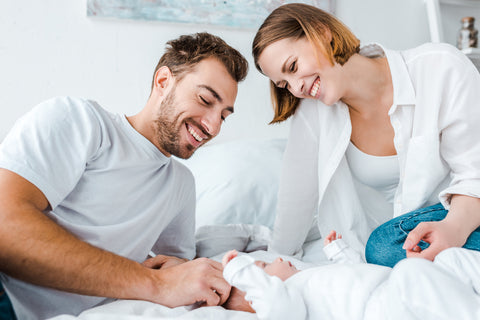
Bigger isn’t always better. Even with a small nursery, you’ll be able to create a comfortable, stylish environment where your little one can grow, play, and slumber the nights away.
Prioritize safety with a Newton Baby Crib Mattress, and then let our small nursery ideas help you figure out how to turn your space into the perfect nursery. In no time, you’ll be welcoming your tiny baby into their new room and your family!
0 comments